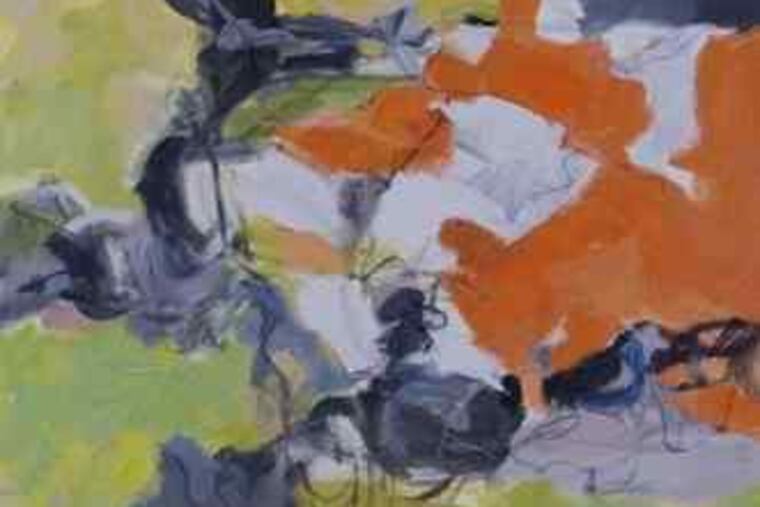Galleries: Shoving demons away to show a playful side
In his last two one-person exhibitions at Gallery Joe, Rob Matthews hewed closely to his themes - his series "The Assumption," from 2005, followed a young man's battles with flying Düreresque demons at the dinner table that appeared to be invisi

In his last two one-person exhibitions at Gallery Joe, Rob Matthews hewed closely to his themes - his series "The Assumption," from 2005, followed a young man's battles with flying Düreresque demons at the dinner table that appeared to be invisible to his wife, while the drawings that made up his 2007 series, "Knoxville Girl," detailed events leading up to the murder of a young woman. (That Matthew's scenes and portraits of the killers were the products of his imagination made them no less chilling.)
The demons, fantastical and human, have been banished for now. Matthews' latest body of work, "It fills us. We arrange it," isn't scary, grisly, or confrontational, has a few themes but no narratives, and seems to catch Matthews in a reflective or playful mood. And for the first time, it's his exquisitely delicate drawing that makes the initial impact.
There are actually two groups of drawings here - one in the gallery proper and one in the Vault space - and though they explore different themes and mediums, his images are all quietly enigmatic.
Landscapes, including views of Philadelphia's Wissahickon Creek that Matthews has deftly altered to appear untouched by man (an existing bridge is missing in his version of Devil's Pool, for instance) make up the graphite drawings in the gallery. The closest Matthew comes to his earlier series is in Tree With Bats, which (fictitiously) depicts dozens of bats nailed to a tree in Fairmount Park, and its ominous companion drawing, Tree With Cans, showing a similar tree in the same area with a pile of empty beer cans at its base.
There are other, more contemplative intimations of mortality in these drawings, such his image of a tree encircled by a snake (a view based on one of Zion National Park, but with the positions of the mountaintops in the background reversed).
Matthews' ink and chalk drawings in the Vault mark an even more obvious shift for him: He's letting his playful side show. Some favorite recurring objects from earlier works are given center stage for the first time, rendered in white chalk on black backgrounds of sumi ink, walnut ink, and Black Magic ink. Here, piles of Mason jars, beer cans (and solo images of both, reminiscent of Johns), a skull, and a vessel with flowers borrowed from the central panel of 15th-century Netherlandish painter Hugo van der Goes' Portinari Altarpiece emerge from the gloom like so many ghosts. Matthews has also made large drawings based on his own rubbings of the raised seals on Mason jars. They look vaguely familiar - a rough image of an eagle, a bridge, a fall harvest - but their blown-up scale gives them a mysterious quality, as if the artist cracked a secret code in these innocent symbols of America's past.
Pentimenti pleasures
Pentimenti Gallery's current group show, "Superimpose," is one of its best ever.
Richard Roth's small, boxy abstract paintings of rectangles determined by intersecting lines (or the other way around) have an affinity with such abstract painters as Stephen Westfall and Andrew Spence - and Paul Feeley before them - but also recall modernist architecture designs.
Cecilia Biagini, a mostly self-taught Buenos Aires artist who studied under Guillermo Kuitca, is showing constructivist-influenced but lighthearted wall sculptures of wood that are painted at their farthest edges, and a sculpture of two hanging constructions of clear Plexiglas tubes painted at their ends. These struck me as a friendly nod to affordable consumer products from Ikea and like-minded home-decor companies.
David Ambrose, who has shown with Pentimenti previously, benefits from this company. In the past, I thought his pin-pricked works on paper too busy, indeterminate. Here, they take those qualities to an obsessive extreme that's hard not to admire.
Earth moves
Jacqueline Cotter's recent abstract paintings at Rosenfeld Gallery are remarkable for compositions that seem wrought from current and past geological events and for their combinations of earthy and simmeringly intense colors. Her
In the Wings
,
Change of Plans
, and
Spreading the Blues
combine these qualities with sublime results.